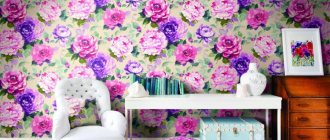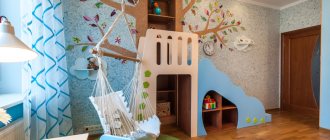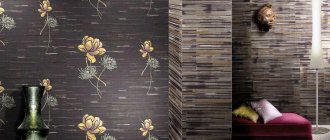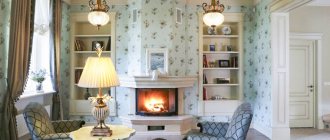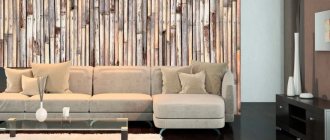Shall we combine?
Walls occupy the largest area in the house, so they play a vital role in creating the atmosphere. It is not enough to simply choose the color of wallpaper or paint and start renovating. Any designer will first determine the characteristics of the room: is it high or low, light or dark, warm or cold, etc. The purpose of the room is taken into account and the style is selected. Then the colors are selected and the finishing method is thought out.
In a spacious and moderately high room, almost any finish can be used. But the question arises: won’t the walls seem empty, thereby depriving the room of a significant amount of comfort? To avoid this, they resort to using combined finishing. The same option is applicable for “problem” rooms, since proper combination will hide the shortcomings and emphasize the advantages.
You can combine different materials, as well as different colors and textures of the same material. For example, in kitchens, as a rule, they use different finishes for the working and dining areas - in this case, one material is rarely sufficient.
In living rooms, they often use a special finish for the TV wall or the wall next to the sofa. In this case, you can combine both materials and colors. The same technique is used for the original design of walls in the bedroom - mainly for the head of the bed.
In fact, combined wall decoration is possible in any room. And in many cases, you can only get by by combining colors, using the same material as a basis - for example, paint or wallpaper.
This time we will talk about combining wallpaper - a very popular technique today that allows you to decorate walls in an original way without spending a lot of effort and money.
vertical stripes
To do this, purchase wallpaper of the same width and texture, but in different colors. The stripes alternate one or two. Two color solutions are possible: monochrome (using wallpaper of similar shades) or contrasting (using wallpaper of different colors).
In the first case (monochrome solution), horizontal stripes will create an interesting play of shadows on the walls. In the second case, the walls will not only be the background for the interior, but also its main highlight, creating the mood of the room.
You can use wallpaper with different patterns: for example, alternate stripes of striped and floral wallpaper. This solution is suitable for a retro-style interior.
Wallpaper sheets can be joined traditionally or in an original way - for example, with a wave, zigzag, etc. But this, of course, is a job for great professionals.
Wallpapering two types: photo ideas
Stripes are combined not only with plain surfaces, but also with patterns. It is important that the interior is in the same colors
Bright heels in a monotonous interior are an ideal option for gluing other types of wallpaper
In the photo, different wallpapers in one room were chosen well, the color is also repeated in textiles
Cover a room with two types of wallpaper? Easily! How about three?
Zoning using different colors is a proven method
Remove the “trailer” effect by breaking up a long wall with a partition and covering it with eye-catching wallpaper.
Options for gluing combined wallpaper: three different types
Vertical stripes “raise” the ceiling
For children, wallpapering two types is also relevant
Arbitrary division of the wall is another interesting approach
Traditions are broken: the lower part is lighter than the upper
Companion wallpapers always go well together
How to hang wallpaper in an original way
The accent is a burgundy wall.
Definitely attracts attention Source
horizontal division of walls
Combining wall decoration horizontally is very common. This technique is used in interiors of almost all styles. Wooden and cork panels are often combined with wallpaper and painting. horizontal division of walls using only wallpaper is no less common It is also possible to combine wallpaper of similar shades or, conversely, contrasting ones. You can combine wallpaper with different textures: for example, cover the bottom of the wall with vinyl wallpaper that imitates plaster, and the top with textile wallpaper.
When dividing walls horizontally by combining wallpaper, it is necessary to use a border to design the joints. A paper border, a polyurethane molding, a wooden batten, or a ceiling plinth will be suitable - the choice, as a rule, depends on the style of the interior and the thickness of the wallpaper. So, if the wallpaper is the same thickness, you can get by with a paper border. But if the thickness of the wallpaper is different, the paper border may lie unevenly.
How to properly divide a wall horizontally? At what height from the floor should I join wallpaper? This also depends on the height of the ceiling. On average, the height of the lower half is 1 meter - this is optimal if the room is low. In a high room, you can make the border between the wallpaper much higher - 1.5 or even 2 meters from the floor.
First, the top sheets are glued, but the bottom of the sheet is not glued. A reserve is left. Then the bottom wallpaper is glued, the top of which is also not glued a little. The allowance must also be left. If you paste wallpaper end-to-end, immediately cutting off the seam allowance, the wallpaper may shrink when drying, causing the joint to increase in size. When both wallpapers are dry, you will need to carefully cut off the excess and glue the wallpaper end-to-end.
Another important point: the junction of the wallpaper should be measured according to the level of the floor, not the ceiling.
Otherwise, when the furniture is placed, the unevenness of the joint in relation to the floor may be noticeable - this will ruin the whole look.
How to compose
There are several techniques for gluing two types of wallpaper, which can be used “in their pure” form or combined two or three at a time. It is important to have a good idea of what exactly you want to achieve.
Vertical combination
Probably everyone knows that vertical stripes visually increase the height of the ceiling. Moreover, the stripes do not have to be regular. In a modern interpretation, one wall can have striped wallpaper, while the rest can be plain-colored or with a dim, barely noticeable pattern.
Thanks to the vertically located ornament, the ceilings seem higher
But this is not always the case. You can distribute vertical stripes on different walls. Moreover, they can be regular - repeated at regular intervals. As you can see in the photo, the spacing on different walls may be different.
Methods for wallpapering: alternating vertical stripes
The stripes can be different - in color or pattern. The texture of this combination of wallpaper should be the same, otherwise you will get an incomprehensible jumble. For such a combination, it is easiest to work with one collection. The fact is that most campaigns release several designs that combine with each other. As a rule, they are available in several colors. One collection has two or three plain backgrounds and several options with patterns.
Second set of colors from the same wallpaper collection
You can see an example of using three wallpapers from one collection in the photos below and above. The combination is almost perfect - they were tested for compatibility many times before starting production. By the way, in most of the other photographs, wallpapers are also combined from the same collection. It’s just that it’s very difficult to combine different textures normally.
Wallpapering three types
When combining vertically, there is another interesting technique that allows you to make the ceiling higher. One of the stripes “extends” to the ceiling. At the same time, the transition boundary is blurred, which gives a feeling of greater volume.
The stripe on the ceiling blurs the boundaries
To make the principle of the stripes a little clearer, we present several options in a graphical representation. The drawings are made as if viewed from above.
How to hang two types of wallpaper
These are win-win options that will always “play” when choosing paintings from one collection. If you need a guarantee that wallpapering two types will be effective, use one of these schemes. This wall design has been tested thousands of times, and every time the result is excellent.
Horizontal division
A technique that can be considered a design classic. It has been used for a long time, but with the current abundance of colors and textures it has acquired a completely new meaning. This technique is more often used in rooms with a small area but high ceilings. Horizontal division of the room helps to remove the “well” effect. It could just be a horizontal strip that encircles the room. It is often tied to the height of the window sills, but in general it is carried out when dividing the plane into three parts and can be located in the lower or upper third.
Horizontal stripe when wallpapering
This rule is often violated: sometimes the strip is made at eye level and some decorative elements are hung at this level. It often looks very good. This technique is often found when decorating corridors and hallways.
It is often necessary to visually reduce the height of ceilings in hallways
The division zone can also extend at the top. Traditionally, the lower part is decorated in darker colors, the upper part is lighter. But this rule is also broken. An example is in the photo below.
Breaking the rules can be fun too
Traditional options for combining two types of companion wallpaper with horizontal division:
- bottom (1/3) - striped wallpaper. top - smoothly painted or with a small pattern;
- bottom - 1/3 - in a small pattern, top - large monograms or plain ones;
- 2/3 at the bottom is a large pattern - monochromatic at the top.
Traditional pasting with horizontal division is one of the options
Zoning
Wallpaper of different colors in one room is also used if it is necessary to emphasize zoning. For example, in studio apartments, different functional areas are divided in this way: dining and relaxation.
The relaxation area is highlighted with wallpaper with a large pattern
The same principle can be applied in a nursery. In this case, gluing two types of wallpaper serves to separate the play area, bed, and table. The same applies if there are two children in the nursery. This is only possible if there is no competition between them, otherwise the number of conflict situations may increase.
Zoning a children's room using different wallpapers
With this combination, the use of different textures is allowed. But separating them with moldings is used very rarely. They try to either join in the corners, or choose wallpaper so that the joint does not look provocative.
Panel or decorative insert
Different wallpapers have been glued in one room for a long time, only once they were made of fabric, and they were decorated in “frames” because they were very expensive and were accessible only to the upper class. Since those times, it has become a custom: gluing two types of wallpaper in the form of a panel. And today classic interiors are decorated in this way, using silk-screen printing, embossed or textured options for insertion.
Wallpaper panels are used in classic interior design
If the style allows, elements of a different color are framed in a molding frame. This design option fits perfectly into classic interiors or Provence and country styles.
A similar panel is also possible in more modern styles - Art Nouveau, for example. But then the frame can be made from a border of the same color - from the same collection, or cut from the “body” of wallpaper.
A panel of wallpaper of a different color in a modern interior
Another option is to paste it into a niche. In this case, the design and texture are selected according to the style, as well as other designs.
Interesting options for wallpapering: a niche of a different color
And in this case, it is best to use wallpaper from the same collection. A professional decorator will select them based on experience or using instinct, but amateurs may not succeed. If you don't want to take risks, use one collection.
Color accents
There are two principles for using this technique. The first is to divert attention from some element that you consider unsightly. For example, uneven walls. In some apartments they may be sloping. To prevent the eye from clinging to this fact, the opposite wall is highlighted with wallpaper of a different color, with or without a pattern. It is important that they attract attention.
Pasting walls with different wallpapers: highlighting the accent
The second technique is gluing two types of wallpaper to attract attention to some object in the interior. In bedrooms this is often either the bed or the opposite wall. Here, who wants to emphasize something (read about choosing wallpaper for the bedroom here). In kitchens, a table is often allocated, thus forming a dining area. This is partly zoning, partly accent. Still, attention is diverted from the kitchen area.
Accenting a wall near a piece of furniture is an interesting way to hang wallpaper in two colors
The actual accent can be not only a vertically directed strip, although this option is more common: our rooms do not have high ceilings, so any means are good. In a tall room, the accent can be a wide horizontal stripe - or some part of the wall, as in the photo below.
Two techniques at once: different colors and different textures
Some rooms have projections of load-bearing walls or niches. Often they try to disguise them. There is absolutely no need to do this. By highlighting this area with wallpaper of a different color, it can be turned into an architectural highlight that will add individuality to the room.
Wallpapering two types: protruding “remnants” of load-bearing walls can be turned into an advantage
In general, the options for hanging wallpaper of different colors in one room are endless. Choose what you like best, and for more ideas, there is a whole section below with different photos.
wallpaper inserts
You can first paint the walls or cover them with wallpaper, and then, on top of the primary finish, glue inserts of thicker wallpaper - for example, on a non-woven base. In this case, wallpaper inserts can be framed with thin strips or moldings. Such decoration of walls with quadrangular or polygonal inserts is typical for interiors in the classical style, as well as in the Baroque and Rococo styles.
Baroque style
The inserts can be figured - for this purpose, wallpaper with a large ornament is taken, according to which the parts for the insert are cut out.
inserts over large areas
You can cover the walls of one room with different wallpapers. This technique allows you to highlight certain zones. For example, the wall on which the TV will hang can be covered with wallpaper that contrasts with the decoration of other walls. You can highlight not the entire wall, but only part of it: for example, use contrasting wallpaper to highlight a relaxation area in the bedroom or to decorate the head of the bed.
An interesting solution for combining wallpaper in the interior: pasting the wall behind the head of the bed with bright wallpaper that extends to the ceiling.
By combining wallpaper of different colors, you can divide a children's room for two children into personal zones: one wall is covered, for example, with orange wallpaper, and the other with green. Each of the residents of this room will have their own zone, highlighted in color. Of course, beds, tables, cabinets, etc. in this case they are placed at different walls.
Combined wallpaper: a means of hiding room imperfections
You can emphasize the architectural advantages or make the disadvantages of the apartment invisible using the following techniques:
- A low ceiling will look much higher if the room is covered with vertical contrasting stripes.
- A large, empty room will become more compact and comfortable if you use a horizontal combination with a predominance of dark tones.
- A small room will not seem so cramped if the wallpaper on the walls combines white or light pastel colors and narrow vertical inserts decorated with moldings.
- An overly large space can also have a depressing effect, so in this case you can use combined wallpaper, including dark colors, wide vertical stripes and ornamental inserts.
- A narrow, long room looks more harmonious if the long parts of the perimeter are covered with light wallpaper, and the short parts with darker shades.
- A square room will “come to life” if you combine wallpaper as follows: one wall has a rich color, the others are lighter and calmer.
- You can highlight your favorite area of the room and distract from shortcomings by highlighting a wall or part of it with interesting and bright wallpaper.
To conclude, we can add that the combination trend has received support from manufacturers. Increasingly, entire collections of wallpapers are being produced that go well with each other in different combinations. Ready-made solutions greatly simplify the process of choosing wallpaper, but at the same time do not prevent you from approaching the issue creatively and choosing combinations to your taste.
“Patchwork” way of combining wallpaper
To do this, choose well-matching wallpapers: for example, wallpapers with different background colors, but with the same or similar patterns. Or wallpaper of the same color, but in different shades (peach, orange, terracotta). Then the wallpaper is cut into pieces of the required size and pasted - in an orderly or chaotic manner, end-to-end or overlapping. You can paste wallpaper of two colors in a checkerboard pattern or imitate a patchwork quilt on the wall. In a word, there is complete scope for imagination!
Transition design
When combining different finishing materials, it is impossible not to pay attention to the place where they join, and wallpaper is no exception. It is not necessary to carefully disguise the transition; on the contrary, you can emphasize and advantageously play up this place. Curbs and moldings come to the rescue. The latter will add elegance to the interior, turning the problem area into a work of art, in the form of a painting or panel. In a children's room or hallway, you can give preference to border tape. It can also imitate molding if you choose high quality specimens.
A smooth transition between different types of wallpaper is also possible. But for the effect of the whole canvas, it is worth paying attention to checking the smoothness of the walls. At the stage of preparation for wallpapering, you need to carefully align all the imperfections on the wall.
design of niches, protrusions, etc.
To draw attention to a niche or ledge, they can be covered with contrasting wallpaper or wallpaper with ornaments with a plain wall decoration. The room will immediately “play.”
A couple of useful tips for combining wallpaper in the interior:
1. When choosing wallpaper to combine, do not rely only on your “color” memory. If you have already chosen one wallpaper and want to choose a pair, carry a piece of wallpaper with you. Although it is better to do a simultaneous selection of wallpapers for combining . By unwinding two rolls a little and placing them one next to the other, you can conclude whether the wallpaper matches each other.
2. For combined wallpaper gluing vertically, you need to choose wallpaper of the same thickness, otherwise nothing good will come of it. The best option: choose wallpaper of the same quality, produced by the same manufacturer, but in different colors or with different patterns.
3. If we are talking about wallpaper, creativity is completely acceptable. Moreover, combined wallpapering allows you to correct shortcomings. So, if you want to visually increase the height of the room, you can simply choose wallpaper with vertical stripes or combine two types of wallpaper by gluing them with vertical stripes. If the room is too high, dividing the wall horizontally by combining wallpaper will make it more comfortable.
Combination ideas for each room
To advantageously highlight the advantages and disadvantages of a room, you need to know the principles of how to correctly combine wallpaper in a room. Practical combinations in the bathroom and kitchen, a romantic mood in the bedroom and a playroom in the nursery. All this can be achieved using the ideas presented below.
Living room
A modern living room can include a lot of purposes: dining room, guest room, etc. When choosing combination options, you need to clearly understand that the living room is a relaxation room. How to combine wallpaper with each other, photos of the hall will indicate the basic rules:
- no need to use too many complex combinations;
- Enlarge a small area using solar combinations;
- dark colors should be used exclusively for accents; for the background, preference should be given to cold and light shades (but not pastels);
- use vertical combinations, inserts with frescoes, bright accents.
Bedroom
Rest and privacy room. In this room you want to immerse yourself in an atmosphere of harmony and calm. Flashy colors and large ornaments are unnecessary here.
- use saturated colors only in tandem with a calm palette;
- choose monochromatic combinations using one finishing material;
- A combination of textile and vinyl wallpaper will allow you to create a harmonious interior;
- create an accent, referring to the character and preferences of the owners (national pattern, adding photo wallpaper with a reference to the activity, etc.)
- use wallpaper inserts.
Kitchen
The room that greets its owners first in the morning. The design task includes not only the ability to evoke appetite, but also to create a positive mood. And for this it is worth considering the nuances:
- it is necessary to choose the style and color of the kitchen after assessing all the main parameters (size, orientation to the cardinal points and illumination);
- combine materials of the same price category (vinyl + paper);
- limit yourself to one or two primary colors, in order to maintain an understanding of the idea of the interior, harmoniously fitting into the tone of the set and furniture;
- When combining different wallpapers, you should take into account the color and texture of the flooring and furniture.
Bath
The use of wallpaper in the bathroom is usually not used due to its low resistance to moisture. But this can be fixed based on the rules:
• choose special wallpaper for wet rooms; • combine with tiles or panels, decorative stone and plaster; • use the method of combination with horizontal zoning.
Children's
In a child's room, preference should be given to his individual wishes. It is necessary to select combinations based on the baby’s temperament. For those who are too active, it is worth giving preference to a calm palette; you need to understand that the color of the walls directly affects the psychological state of the child.
- zoning the space in accordance with the activity (large drawings are not acceptable in the study area, flashy colors are not acceptable near the bed);
- the use of fairy-tale scenes, wallpaper inserts, patchwork combinations, or vertical, with a washable lower part;
- combining wallpaper with a theme transition to the ceiling is a very unusual and interesting move.
Hallway
The zone by which the taste of the owners is assessed. Despite the short duration of your stay in it, it is worth paying special attention to the hallway. Even a small entrance area can be visually expanded and given a stylish and cozy look.
- using vertical combination to lengthen a small room;
- choose a material that is moisture-resistant so that it can withstand frequent washing;
- a combination of bamboo and cork, with vinyl wallpaper or glass wallpaper is an excellent combination option;
- When choosing several types of wallpaper, you need to give preference to the same width.
